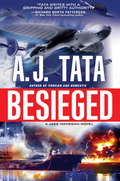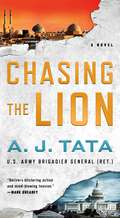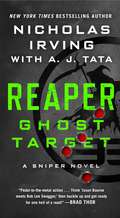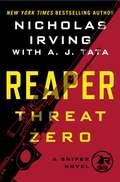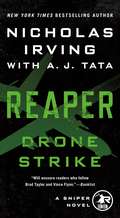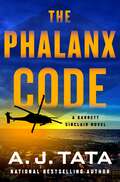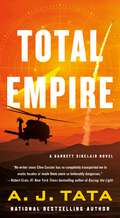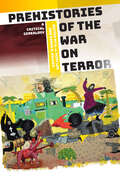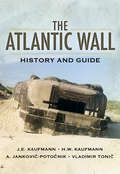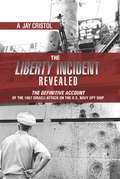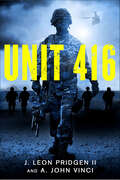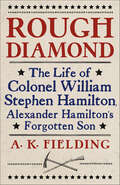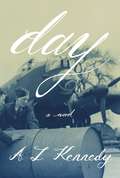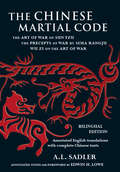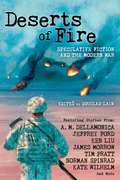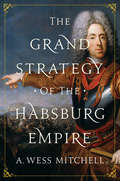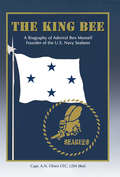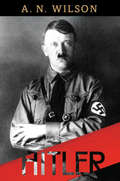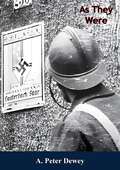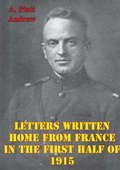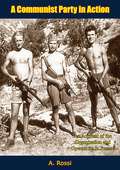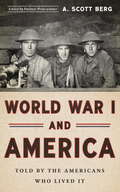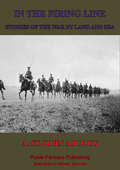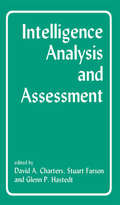- Table View
- List View
Besieged
by A. J. TataPowerful, thrilling, and explosively authentic, the novels of Brigadier General A.J. Tata have won acclaim from President George W. Bush, Glenn Beck, and the bestselling masters of suspense. In Besieged, he tackles the rise of domestic terrorism in America—and puts his hero, Jake Mahegan, in the crackling center of a firestorm. . .It starts with the unthinkable. A school under siege. A shooter in the classroom. A nightmare scenario that has become all too common in today’s United States. But this time, former Delta Captain Jake Mahegan is there when it happens.Checking in on the schoolteacher daughter of a colleague, Mahegan finds himself face to face with a merciless gunman rigged as a suicide bomber. Without warning, the school is attacked from the outside as well—and all hell breaks loose. The teacher shoots the gunman, Mahegan is knocked unconscious, and a twelve-year-old autistic girl named Misha is kidnapped.When the smoke clears, Mahegan is left with a long list of unanswered questions—and a deeply personal mission to rescue Misha. Racing against the clock, his search will take him from the tech-fueled think-tanks of a North Carolina factory to the top-secret nerve centers of embedded Iranian agents. It’s all part of a bigger, darker conspiracy that’s taking domestic terrorism to a whole new level. And it’s up to Mahegan to stop what could be the most devastating attack in U.S. history. . .
Chasing the Lion: A Garrett Sinclair Novel (Garrett Sinclair #1)
by A. J. Tata"Readers are going to love Garrett Sinclair, who reads like this generation's Jason Bourne." —Ryan Steck"If you are looking for a good night’s sleep, leave this one in the nightstand." —Jack CarrParizad rose through his nation’s military to become a lethal soldier and brilliant tactical commander. Now a general, he leads Quds Force, an extremist terrorist organization targeting America and its western allies.The United States has just uncovered a biochemical weapon developed by Parizad’s group. A viral agent, it attacks a person’s nervous system and renders them susceptible to mind control. Parizad plans to unleash the weapon in Washington D. C. on Inauguration Day during the swearing in of the country’s first female president, turning civilians into weapons.Army Lieutenant General Garrett Sinclair and his Joint Special Operations team are assigned to stop the terrorist strike. Sinclair pursues Parizad across the Middle East, Europe, and in the U.S., only to discover a deeper conspiracy—a revelation that his wife may not have died from cancer but was murdered. Separated from his teammates and unsure of who he can trust, Sinclair is on a mission not only to save his country, but to avenge his family.
Reaper: A Sniper Novel (The Reaper Series #1)
by A. J. Tata Nicholas IrvingThe explosive new thriller series written by Nicholas Irving, the New York Times bestselling author of The Reaper and star of Fox's American Grit."Wow! Irving & Tata make an incredible team. Reaper: Ghost Target is pedal-to-the-metal action packed with great twists and turns. Think 'Jason Bourne meets Bob Lee Swagger' then buckle up and get ready for one hell of a read!" —Brad Thor, #1 New York Times bestselling author of Use of Force“A compelling and intriguing tale, layered with suspense, told by two people who know what they’re talking about. This one goes on your keeper shelf.” —Steve Berry, New York Times bestselling author of The 14th Colony American hero, or unhinged vigilante?In Reaper: Ghost Target, Vick "The Reaper" Harwood is an esteemed sniper with a record kill count—33 kills in 90 days—when he is knocked out under mortar attack in Afghanistan. He wakes up back in the United States with little memory of what happened, his spotter and gun both unrecovered from the battlefield. Harwood has resigned himself to slowly picking up the pieces of his life, training Special Forces snipers in Fort Bragg, North Carolina, and starting a promising relationship with an Olympic medalist named Jackie. But when a series of assassinations start occurring in the area, Harwood can't explain why he just happens to be nearby for each killing—or how a sniper rifle that matches the description of the one he lost seems to be involved. His memory of the past few days is hazy and full of blackouts, and even he has to wonder, is he being framed? Or is he the killer?As Harwood runs from the authorities, his girlfriend falls off the radar, his missing spotter resurfaces, and the assassinated men are outed as drug and sex traffickers. Nothing is adding up. Harwood realizes he has to unravel this mystery, and fast, or find himself paying the ultimate price for crimes he may not have committed.
Reaper: A Sniper Novel (The Reaper Series #2)
by Nicholas Irving A. J. TataThe next book in the explosive new thriller series by former special operations sniper and New York Times bestselling author of The Reaper. A convoy of cars carrying several family members of the President’s cabinet to Camp David for “Family Day” is ambushed, killing and wounding wives, husbands and children.Immediately in the aftermath, Vick Harwood watches a Facebook live feed of his former ranger buddy Sammie Samuelson’s apparent suicide and confession in his Thurmont, Maryland apartment, just one mile from Camp David. Remnants of a firefight are in the background: sniper rifle, rocket launchers, and ammunition. Simultaneously, an intruder breaks into Harwood’s house.Harwood arrives in Thurman to investigate the suicide and, with the help of attractive FBI agent Valerie Hinojosa, traces evidence left by Samuelson to a fiendish plot involving transnational terrorists and domestic political opponents.Meanwhile, the president wants retribution, and will stop at nothing to get it. Harwood joins Team Valid, whose mission is to kill the family members of terrorists and eliminate their seed from the earth. Team Valid, consisting of Hinojosa, Harwood, a Navy SEAL sniper, and a Marine Force Recon sniper, travels to Crimea, Iran, and Azerbaijan before realizing the mission is not what it seems. Harwood struggles to balance his orders with his sense of right and wrong—without losing his life in the process. As Samuelson is implicated in the Camp David ambush, it is a race to protect his remaining family and uncover the sinister plot in the homeland.
Reaper: A Sniper Novel (The Reaper Series #3)
by Nicholas Irving A. J. TataNicholas Irving's Reaper: Drone Strike is the next book in the explosive thriller series by the former special operations sniper and New York Times bestselling author of The Reaper. On a classified mission to help the Israeli Defense Forces stop a Syrian and Hezbollah invasion to seize the Golan Heights, Ranger sniper Vick Harwood and his spotter go deep undercover. Operating with limited support from the American and Israeli governments, Vick is out on the edge. Alessandra Cavezza, Director of Operations in Syria for the Italian UN Commission for Refugees, is moving families out of an embattled neighborhood. The nearly vacant suburb has been a haven for anti-Assad forces, ISIS militants, and Russian private military contractors. As she crawls into the basement of a home to help find a young girl’s doll, she finds a secret room that has detailed descriptions of unthinkable attacks on the United States, and falls into the hands of a madman: Jasar Tankian, Lebanese mastermind behind the plots. As Syrian tanks attempt to push through Israeli defenses at the border, Team Reaper picks off Syrian tank commanders as they battle Israeli tanks, jets, and infantrymen. Combat intensifies as Vick goes black on ammunition. Commandeering a cargo drone to deliver Team Reaper to a landing zone near the coordinates, Vick becomes Alessandra’s—and America’s—only hope for survival.
The Phalanx Code: A Garrett Sinclair Novel (Garrett Sinclair #3)
by A. J. TataGarrett Sinclair escapes from prison to rescue his team from the manipulations of two tech moguls and learns of a devastating family secret in the process.Influential tech magnate Mitch Drewson calls on Sinclair and the Dagger team to protect his Project Optimus. An ambitious endeavor that empowers citizens to protect their financial and personal data in the face of increasingly authoritarian federal governments, Project Optimus is a threat to Aurelius Blanc’s Phalanx Corporation. Blanc’s data collection and media application are enabling a global security threat, creating a technofascism that monitors the activity of everyone with a smartphone, tablet, computer, or any web-connected device.When Phalanx assassin squads overrun an Optimus server farm in California and attack an Optimus coder named Blair Campbell, who happens to be the president’s daughter, Sinclair must deploy a group of warriors to save Blair and protect the remainder of the Optimus team so they can finish their important work—a project that includes deciphering the mysterious Phalanx Code, suspected to be Phalanx’s kill list of Optimus employees.With Phalanx squads hunting him and those he loves, Sinclair must determine who he can trust while a part of his past comes back to haunt him and threaten everything he holds dear. Nonstop action and authentic detail make this the most compelling, high-stakes entry in the Sinclair series yet.
Total Empire: A Garrett Sinclair Novel (Garrett Sinclair #2)
by A. J. TataGeneral Garrett Sinclair undertakes a rogue mission in the Sahara Desert to thwart an international nuclear threat in Total Empire, an explosive thriller from A. J. Tata.When Sergeant Major Sylvester “Sly” Morgan is killed on a mission, his daughter, Zoey, tells General Garrett Sinclair that her father's death wasn’t random. Morgan had recorded a high-level meeting between Chinese, American, and French diplomats as they spoke about a plan for a new global government.The “Chinese-U.S. Partnership”, or CUSP, intends to combine the world’s two largest economies and militaries to usher in a new era of partnership and leadership. But China’s offer has a deadline and penalties for noncompliance. As a safeguard, China has five high-tech hypersonic glide vehicles armed with nuclear weapons orbiting the earth ready to strike. When Zoey disappears in Africa, seemingly while in pursuit of her father’s killer, Sinclair and Dagger Team are caught off-guard as they scramble to catch up.Without authorization or support from his government, Sinclair takes his team into the maw of the Saharan death pit, the Eye of Africa. In what will prove to be his most dangerous mission yet, Sinclair must overcome tremendous odds, with the threat of nuclear Armageddon hanging in the balance.
Prehistories of the War on Terror: A Critical Genealogy (Power, Politics, and the World)
by A. J. Yumi Lee and Karen R. MillerReveals fundamental continuities between the contemporary War on Terror and earlier U.S. imperial conflictsPrehistories of the War on Terror examines the longstanding American project of classifying enemies who challenge U.S. power abroad as terrorists. To do so, the volume brings disparate episodes of U.S. military empire-building into dialogue across time and space. From settler colonial wars in the nineteenth-century American West to twentieth-century wars of conquest in Asia and the Pacific, the collection’s essays argue that the United States has drawn both materially and ideologically on older systems of empire in the conflicts through which it has waged the present-day War on Terror.Attending to the local histories from which these conflicts emerged and examining the effects of U.S. intervention in these sites, contributors analyze the cultural frameworks for understanding and remembering past conflicts that confirm, challenge, or refigure the logics of the War on Terror. This volume reveals how contestations over sovereignty, extraction, and inequality must be suppressed and flattened in public discourse to maintain a coherent vision of a totalizing War on Terror. Together, the contributors illustrate that there was no single road that led to 9/11 or the War on Terror. Rather, they argue that we must follow multiple paths into the past to fully understand our present and to fight for a more just future.Contributors: Moustafa Bayoumi, Joo Ok Kim, Janne Lahti, A. J. Yumi Lee, Naveed Mansoori, Karen R. Miller, Kalyan Nadiminti, Tim Roberts, Colleen Woods.
America, War and Power: Defining the State, 1775-2005 (War, History and Politics)
by Lawrence Sondhaus A. James FullerWritten by leading historians and political scientists, this collection of essays offers a broad and comprehensive coverage of the role of war in American history. Addressing the role of the armed force, and attitudes towards it, in shaping and defining the United States, the first four chapters reflect the perspectives of historians on this central question, from the time of the American Revolution to the US wars in Vietnam and Iraq. Chapters five and six offer the views of political scientists on the topic, one in light of the global systems theory, the other from the perspective of domestic opinion and governance. The concluding essay is written by historians Fred Anderson and Andrew Cayton, whose co-authored book The Dominion of War: Empire and Liberty in North America, 1500-2000 provided the common reading for the symposium which produced these essays. America, War and Power will be of much interest to students and scholars of US military history, US politics and military history and strategy in general.
The Atlantic Wall: History and Guide
by A. Jankovic-Potocnik H. W. Kaufmann J. E. Kaufmann Vladimir TonicThis WWII history and visitor&’s guide explores the extensive network of Nazi fortifications built to defend Fortress Europe. Hitler's Atlantic Wall, the complex system of coastal fortifications that stretched from Norway to the Spanish border during the Second World War, was built to defend occupied Europe from Allied invasion. Many of its principal structures survive and can be visited today. This authoritative guide provides both practical information for visitors and essential historical context. The wall, which was constructed on a massive scale between 1942 and 1944 by German engineers, forced laborers and troops, consisted of strong points, artillery casemates, bunkers, troop shelters, minefields, anti-tank and anti-boat obstacles. It also included the concrete U-boat and E-boat pens in the key ports and, behind the Channel coast, the V-weapon sites. This huge scheme of fortifications was one of the longest series of defensive lines in military history. This comprehensive volume takes readers and visitors through the entire story of the fortifications from the fall of France to the D-Day invasion on the beaches of Normandy that finally broke through. As a guide to some of the most impressive relics of the Second World War, this book is essential reading for travelers or anyone interested in the liberation of occupied Europe.
The Liberty Incident Revealed
by A. Jay CristolCutting through all of the controversy and conspiracy theories about Israel's deadly attack on the USS Liberty in June 1967 at the height of the Six Day War, Cristol revises his well-regarded book about the event with a complete, in-depth analysis of all of the sources, including recently released tapes from National Security Agency. When the first edition of The Liberty Incident was published in 2002 there remained many unanswered questions about Israeli Air Force audio tapes intercepted by the NSA. Some alleged they would prove that the Israeli attack was premeditated. Cristol's successful Freedom of Information Act lawsuit against the National Security Agency, while resulting in the release of those tapes, has been greeted by anti-Israel sources insisting that the NSA tapes are fraudulent and are part of a larger conspiracy to deceive the American public!After a quarter of a century of intensive research in Israel and the U.S., researching all relevant archives from NSA, CIA and the State Department, reviewing both formerly classified and open source documents, and interviewing all then-living individuals directly involved in the incident, the factual and documentary record is clear. Cristol maintains that despite the fact that all of the official records and transcripts are now available for review, the truth has proven to be of no interest to those individuals and organizations who are motivated by hidden agendas, wish to keep conspiracy theories alive, or are trying to feed sensational stories to the media. Documenting his findings in six new chapters, Cristol establishes in THE LIBERTY INCIDENT REVEALED that the Israeli attack was a tragic mistake and presents a convincing argument that will be regarded as the final story about this incident.
Unit 416
by J. Leon Pridgen II A. John VinciFive tough as nails men. One hard-assed Sergeant. The only chance to change their lives. These are the men of Unit 416. Push them hard and they push harder. Things are about to get deadly—but with the skill and swagger of Unit 416, no mission is impossible…Born and raised in America’s hardest streets, five men are faced with the ultimate choice: continue their lives of crime and incarceration or serve their country and join the Army. Master Sergeant Keeble is faced with no good choice: be the leader of a new section called Unit 416 or take him and his surgically-repaired leg out of the game for good. At first, all Keeble has to work with is a ragtag group of men with no regard for the rules and a huge chip on their shoulders. But as the men go through training and more together, they form a group so tight, so formidable, that nothing can break them apart. And when a secretive CIA directive leads them straight into the heart of Uzbekistan to infiltrate an arms cartel, Unit 416’s men will need all the grit, tough—and heart—they have in order to see this mission home.
Rough Diamond: The Life of Colonel William Stephen Hamilton, Alexander Hamilton's Forgotten Son
by A. K. FieldingSolider, politician, miner, pioneer, scion of a Founding Father, William Stephen Hamilton led a prolific life. Rough Diamond: The Life of Colonel William Stephen Hamilton examines the tumultuous early Republic period of American history through the life of Alexander Hamilton's son.Born in New York in 1797, the fifth son of Alexander Hamilton, he was only seven when his father was infamously killed in a duel with Vice President Aaron Burr. After resigning from West Point, Hamilton moved to frontier Illinois in 1817. The famous name of Hamilton that may have acquired him rank and prestige at one time was meaningless in a Midwestern frontier society driven by the Jacksonians. Yet, despite being hurled into a clash of economic, political, and cultural cultures, Hamilton determined to live his life by his own rules. A veteran of the Winnebago and Black Hawk Wars, Hamilton was elected to the Illinois House of Representatives before moving to the Wisconsin territory, where he founded the mining town of Hamilton's Diggings (Wiota, WI). When gold was discovered in California in 1848, he traveled west, where he would die in Sacramento in 1850.In Rough Diamond: The Life of Colonel William Stephen Hamilton, author A. K. Fielding expands the story of the Hamilton family. Hamilton's life offers a firsthand account of the formation of the Midwestern states, the realities of life on the frontier, and mass migration caused by the California Gold Rush.
Day (Vintage Contemporaries)
by A. L. KennedyAlfred Day wanted his war. In its turmoil he found his proper purpose as the tail-gunner in a Lancaster bomber; he found the wild, dark fellowship of his crew, and - most extraordinary of all - he found Joyce, a woman to love. But that's all gone now - the war took it away. Maybe it took him, too. Before Hitler and the bombs he was a boy in Staffordshire, helpless to defend his mother, to resist his abusive father. The RAF gave him order, skills, another family and a way to be a man. It taught him how to burn through lifetimes on night ops and brief, sweet leaves, surviving the unsurvivable. But it didn't prepare him for capture, for the prison camp and the chaos as the war wound down. It didn't prepare him for an empty peace. Now it's 1949 and Alfred is doing the impossible again, winding back time to see where he lost himself. He has taken the role of an extra in a POW film. Shipped out to Germany and an ersatz camp, he picks his way through the clicheacute;s that will become all that's left of his war and begins to do what he's never dared - to remember. He is looking for some semblance of hope: trying to move forward by going back. A superbly realised novel about the brutal simplicities of war - of horror, and the camaraderie found in the closeness to death - and a moving exploration of the complexities of human emotion, Day is a wonderful piece of storytelling: the freight of history and humanity carried effortlessly by the beauty of the writing. For previous readers of A. L. Kennedy's books the dark humour, close observation and thrillingly original language will come as no surprise; for new readers, this novel will be a revelation.
Chinese Martial Code
by A. L. Sadler Edwin LoweFor millennia the classics of Chinese martial strategy have been studied and their lessons applied with devastating success by warlords and military generals and today this timeless advice is analyzed as much for its application in the boardroom as on the battlefield-as thousands of Asian businessmen can attest.Chinese Martial Code provides clear, easy to follow translations of three of the most respected works on strategy in history, featuring a masterful translation of The Art of War of Sun Tzu--the most respected of all works of military strategy--as well as the less famous but equally wise Precepts of Ssu Ma Jang Chu and Wu Chi On the Art of War.Additionally, A. L. Sadler's translation is converted here into Pinyin for the first time and the original Chinese language versions of these classic texts are also included, making this title a treasure to Chinese history and military scholars as well. The text is also copiously annotated, placing its sage advice in perspective for modern readers planning to use these time-tested strategies to conquer the business world.
Deserts of Fire: Speculative Fiction and the Modern War
by Kate Wilhelm Norman Spinrad James Morrow Jeffrey Ford Tim Pratt A. M. Dellamonica Ken Liu Douglas LainSpeculative fiction stories that explore the ambiguities of war—from award-winning, bestselling authors Jeffrey Ford, Ken Liu, Kate Wilhelm, and others. In the tradition of In the Field of Fire, a collection of stories with a Vietnam War theme, Deserts of Fire is a war-inspired anthology for the new millennium. For many, the recent wars in the deserts of Iraq, Afghanistan, and the Middle East are just as slippery to grasp and difficult to understand as Vietnam was two generations earlier. Inside Deserts of Fire are stories from a variety of bestselling and award-winning authors that start with the simple and modest ambition of making the reader feel strange about the recent past. Because when there are too many explanations, the truth won’t be found by merely choosing one side or the other. But rather, the truth is in the existence of the confusion itself.
The Grand Strategy of the Habsburg Empire
by A. MitchellThe Habsburg Empire’s grand strategy for outmaneuvering and outlasting stronger rivals in a complicated geopolitical worldThe Empire of Habsburg Austria faced more enemies than any other European great power. Flanked on four sides by rivals, it possessed few of the advantages that explain successful empires. Its army was not renowned for offensive prowess, its finances were often shaky, and its populace was fragmented into more than a dozen ethnicities. Yet somehow Austria endured, outlasting Ottoman sieges, Frederick the Great, and Napoleon. The Grand Strategy of the Habsburg Empire tells the story of how this cash-strapped, polyglot empire survived for centuries in Europe's most dangerous neighborhood without succumbing to the pressures of multisided warfare.Taking readers from the War of the Spanish Succession in the early 1700s to the Austro-Prussian War of 1866, A. Wess Mitchell argues that the Habsburgs succeeded not through offensive military power or great wealth but by developing strategies that manipulated the element of time in geopolitical competition. Unable to fight all their enemies at once, the Habsburgs learned to use the limited tools at their disposal—terrain, technology, and treaty allies—to sequence and stagger their conflicts, drive down the costs of empire, and concentrate scarce resources against the greatest threat of the moment. Rarely holding a grudge after war, they played the "long game" in geopolitics, corralling friend and foe alike into voluntarily managing the empire's lengthy frontiers and extending a benign hegemony across the turbulent lands of middle Europe.A study in adaptive statecraft, The Grand Strategy of the Habsburg Empire offers lessons on how to navigate a messy geopolitical map, stand firm without the advantage of military predominance, and prevail against multiple rivals.
The King Bee
by A. N. OlsenBen Moreell was the first non-Naval Academy graduate to be awarded the four stars of an Admiral. He is still the only staff corps officer to be promoted to Admiral. The history of the U.S. Navy Seabees and the biography of Admiral Ben Moreell are inseparable. Immediately after the Japanese attack on Pearl Harbor, he began forming the construction units that ultimately became known as the Seabees. The first battalion of Seabees deployed from the U.S. on 27 Jan. '42. This instantaneous effort to recruit, train, organize, equip and deploy a military unit is still recognized as an amazing achievement. Ultimately over 300,000 Seabees were involved during WW II. The Seabees built and operated the equipment needed to get troops, equipment and supplies ashore in every amphibious landing of WW II. Beginning in North Africa and continuing to Sicily, Italy and Normandy, they were an essential element of the invasions of Europe. But their island hopping campaign throughout the Pacific with the Marines really made their reputation.They participated in every Pacific invasion together with the Marines with the exception of Guadalcanal, where they arrived about three weeks after the First Marines went ashore. Following the invasions, the Seabees built every sort of facility required by the Marines and the Navy; piers, runways, fuel storage, hospitals, ammo storage, dry docks, and more. The accomplishments of the Seabees continued through Korea, Viet Nam and the middle east. The unique aspect of the fighter-builder Seabees generated a need for a command structure that could respond to both elements at any time. Recognizing this critical feature Moreell achieved a major change to Navy Regulations and obtained the authorization for Civil Engineer Corps officers to be given command of the Seabees. They are still the only staff corps officers who enjoy the privilege of commanding fleet units.Moreell also directed the massive mobilization and construction effort for the Navy and Marine Corps throughout the war as well as dealing with unions, congress, manufacturers, and an ever growing federal bureaucracy. His open and honest dealings were recognized by all and contributed to the successful accomplishments of the Bureau of Yards and Docks during that time.But it Seabees remain his crowning military achievement.Their success in W W II was recognized by Fleet Admiral Chester Nimitz in a Seabee birthday anniversary letter to Moreell in which he stated, "....without them we could not have beaten the (Japanese)."An advisor to four Presidents, Ben Moreell's actions forever placed the Civil Engineer Corps and the Seabees solidly in Navy history and tradition.
Hitler
by A. N. WilsonA ruthless dictator who saved his country from economic ruin only to nearly destroy it#151;and an entire people#151;in his quest for world domination, Adolf Hitler forever changed the course of history. In this masterful account of Hitler’s life, biographer A. N. Wilson pulls back the curtain to reveal the man behind the mythic figure, shedding new light on Hitler’s personality, his desires, and his complex relationship with the German people. While Hitler maintained that his life had been characterized by #147;struggle” from its very beginnings, Wilson shows that the reality could not have been more different. Hitler grew up in middle-class comfort and, as a young man, lacked ambitions of any sort besides a vaguely bohemian desire to become an artist. And while the Hitlerian mythos holds that he forged his skills as a leader during the First World War, Wilson explains the truth: Hitler spent most of the war as an office boy miles from the front lines, and only received his cherished Iron Cross because of his slavishness to the officers he served. The army gave him a sense of purpose and brotherhood, however, which continued to inspire Hitler once the war ended. Hitler left the army with no skills, contacts, or money#151;and yet, within fourteen years, he would become chancellor of the German nation. Wilson describes the story of Hitler’s ascent as one of both opportunism and sheer political shrewdness. He possessed no real understanding of the workings of government but had a prodigious knack for public speaking, and found that a large number of Germans, despairing at their country’s recent defeat and terrified by the specter of international communism, were willing to listen to the right-wing fantasies that had taken root inside his head. Allying himself with the extremist German Workers’ Party (soon renamed the National Socialist Party), Hitler offered many Germans a seductive vision of how the country might raise itself back up and reclaim its rightful place at the center of world politics. Wilson shows that, although Hitler’s bid for power stalled at first, he soon gained traction with a German public starved for hope. Using his skills as a manipulator, Hitler found himself first at the head of the Nazi Party, then at the helm of the German nation. Wilson explores the forces that allowed Hitler to become Chancellor of Germany, and later to march Germany into total war. He examines Hitler’s increasingly virulent anti-Semitism and his decision to implement the Final Solution to exterminate European Jews, and he considers Hitler’s tactical successes#151;and failures#151;in World War II. Wilson also reveals a great deal about how Hitler’s personal life affected his time as Germany’s leader, from the lasting pain caused by the death of his mother and the suicide of his young niece to his poor health and addiction to the drugs prescribed by his doctor. As Wilson demonstrates, Hitler the Führer was not so different from Hitler the bohemian: lazy, moody, and hypersensitive, he ruled more through intimidation and the mystifying force of his personality than through any managerial skill or informed decision-making. His story#151;and that of Germany#151;is ultimately a cautionary tale. In a modern era enamored with progress, rationality, and modernity, it is often the darkest and most chaotic elements of society that prove the most seductive. Hitler’s unlikely rise to power and his uncanny ability to manipulate his fellow man resulted in the deaths of millions of Europeans and a horrific world war, yet despite his colossal role in world history, he remains mythologized and, as a result, misunderstood. In Hitler, A. N. Wilson limns this mysterious figure with great verve and acuity, showing that it was Hitler’s frightening normalcy#151;not some otherworldly evilness#151;that makes him so truly terrifying.
As They Were
by A. Peter DeweyAS THEY WERE By LT. COL. A. PETER DEWEYWith the war ended, too many people have already forgotten the dark and uncertain days France knew in 1939-40. But Lieutenant-Colonel Dewey did not forget. He was not the sort of American who could live through such a period and fail to remember. In the simplicity of his book, he has shaped the terror and dissolution of a great people and country. Other writers have told of the corruption in the highest levels of French politics and society; other writers have spoken of the courage that far outweighed the treachery. But none has been able to catch the fevered hopelessness, the panic of those two years. As a Paris correspondent, Dewey was in a position to observe and analyze, and gasp in amazement, at the events which led to the brutal transformation of a great power into a defeated crushed nation. But he has wisely stayed away from the cut-and-dried analyses of political maneuvers and results. He has concentrated upon these hectic days as they affected the individual. His interest was on a human level—the small personal tragedies as well as the great, the death of a child along a refugee-clogged road as well as the decimation of a regiment.AS THEY WERE is not only the story of the early days of this late war as it has never been told before; it is also the story of a sensitive, wise young man who managed to combine an almost delicate culture and a classic intellect with practical ability. Peter Dewey is now dead—killed in action, while serving as a Lieutenant-Colonel in the OSS. He died as courageously as he lived, his physical daring surpassed only by his moral courage. Of his book, Arthur Krock has said: “This is one of the most absorbing accounts of what happened in France in 1939 and 1940 that I have seen—deftly woven into the story of a gallant personal experience are the tragic elements of the debacle.”
Letters Written Home From France In The First Half Of 1915
by A. Piatt AndrewThis volume of the collected letters of A Piatt Andrew form a fascinating insight into the formation of the justly famous American Field Service which did so much help the Allied wounded during the First World War."Col. Andrew was one of the first Americans to take an active part in the World War. Going to France in December 1914, he secured from the French Army authorization for American volunteer ambulance units to serve with the French divisions at the front, and with American volunteers as drivers, and with cars purchased from American donations, he built up an organization known as the American Field Service, which, before any American troops had arrived in France, had thirty-four ambulance sections and twelve camion sections serving with the French troops in France and in the Balkans. This organization took part in every great battle in which French troops were engaged in 1915, 1916 and 1917, and with its personnel of more than 2,400 young Americans, formed the most considerable organized representation which the United States had on the battle front during the first three years of the war."After the entry of the United States in the war, Col. Andrew turned over to the American Army the efficient organization which he had developed, and was commissioned Major, and subsequently Lieutenant-Colonel in that Army. His period of service with the French and American armies covered more than four and a half years. He was decorated by the French Army with the Croix de Guerre, and the Legion of Honor, and by the United States with the Distinguished Service Medal." - National Cyclopedia of American Biography
A Communist Party in Action: An Account of the Organization and Operations in France
by A. Rossi Dr Willmoore KendallRecent events in the United States have shown the workings of little-known elements of the Communist Party, like the secret section whose members are unknown to the rank and file. All this and much more is explained in Rossi’s remarkable disclosure of the entire structure of the Communist Party of one country—in this case France—where we are able to see the Party as it acted under the varying pressures of peace, war, and armistice; how it operates as a legal part of the political scene; how readily it can go underground; how the members are schooled in its principles (an hour-a-day reading of the primary Party books is required); how the overall directives are issued and carried out; how a mass following was to be recruited from the disaffected veterans of the lost war, distraught housewives and families of prisoners, from labor unions and peasants in the Catholic hinterland.This book, based on published and unpublished sources, provides a vast fund of information about the whole range of Communist activities, from the secret instructions that foresaw, in the early days of the German occupation, that the Nazi tolerance of the Party in France would be short-lived to advice on how to meet a comrade with the least chance of being observed. It shows why Party members returning from prison must always be regarded with suspicion, and how and through what means the eventual seizure of the government was to take place. These observations are based on the operations of the French Communist Party, but they apply with only minor changes to the Communist parties of all the Western countries, with their dexterous capacity for maneuver and their unrelenting pursuit, ruthless and with no holds barred, of the ultimate goal of the seizure of power.
World War I and America: Told By the Americans Who Lived It (Library of America ##289)
by A. Scott BergFor the centenary of America's entry into World War I, A. Scott Berg presents a landmark anthology of American writing from the cataclysmic conflict that set the course of the 20th century. Few Americans appreciate the significance and intensity of America's experience of World War I, the global cataclysm that transformed the modern world. Published to mark the centenary of the U.S. entry into the conflict, World War I: Told by the Americans Who Lived It brings together a wide range of writings by American participants and observers to tell a vivid and dramatic firsthand story from the outbreak of war in 1914 through the Armistice, the Paris Peace Conference, and the League of Nations debate. The eighty-eight men and women collected in the volume--soldiers, airmen, nurses, diplomats, statesmen, political activists, journalists--provide unique insights into how Americans of every stripe perceived the war, why they supported or opposed intervention, how they experienced the nightmarish reality of industrial warfare, and how the conflict changed American life. Richard Harding Davis witnesses the burning of Louvain; Edith Wharton tours the front in the Argonne and Flanders; John Reed reports from Serbia and Bukovina; Charles Lauriat describes the sinking of the Lusitania; Leslie Davis records the Armenian genocide; Jane Addams and Emma Goldman protest against militarism; Victor Chapman and Edmond Genet fly with the Lafayette Escadrille; Floyd Gibbons, Hervey Allen, and Edward Lukens experience the ferocity of combat in Belleau Wood, Fismette, and the Meuse-Argonne; and Ellen La Motte and Mary Borden unflinchingly examine the "human wreckage" brought into military hospitals. W.E.B. Du Bois, James Weldon Johnson, Jessie Fauset, and Claude McKay protest the racist treatment of black soldiers and the violence directed at African Americans on the home front; Carrie Chapman Catt connects the war with the fight for women suffrage; Willa Cather explores the impact of the war on rural Nebraska; Henry May recounts a deadly influenza outbreak onboard a troop transport; Oliver Wendell Holmes weighs the limits of free speech in wartime; Woodrow Wilson envisions a world without war. A coda presents three iconic literary works by Ernest Hemingway, E. E. Cummings, and John Dos Passos.With an introduction and headnotes by A. Scott Berg, brief biographies of the writers, and endpaper maps.
In The Firing Line: Stories Of The War By Land And Sea
by A. St. John AdcockArthur St. John Adcock was a novelist and poet of great repute in the early decades of the twentieth century. A noted journalist on Fleet Street, his great experience and literary acumen were ideal qualifications to produce this anthology volume of war stories from the frontlines of the First World War. Weaving the letters, diaries and reminiscences of the eye-witnesses, soldiers and officers who fought during the opening months of the war, he covers the battles around Mons, the destruction of Louvain, the fighting at Ypres and the first battle of the Marne and naval engagements in the North Sea.Well worth a read.
Intelligence Analysis and Assessment (Studies in Intelligence)
by David A. Charters Glenn P. Hastedt A. Stuart FarsonThese essays cover: assessment systems now in place in Britain, the USA, Germany and Australia; the bureaucratic dynamics of analysis and assessment; the changing ground in intelligence; and the impact of new technologies and modes of communication on intelligence gathering and analysis.
